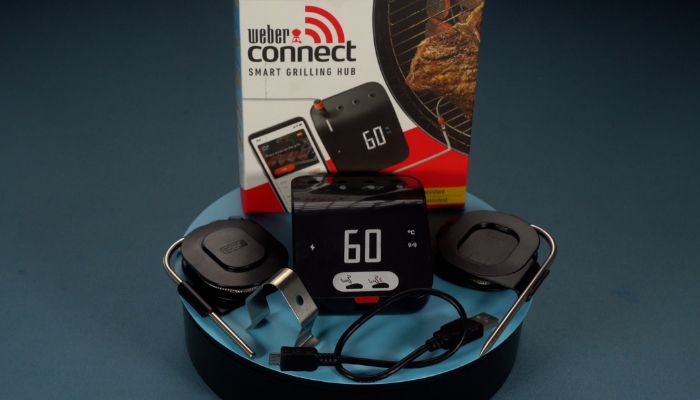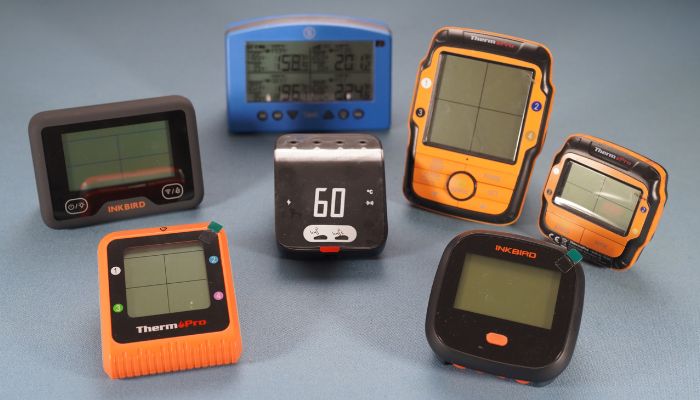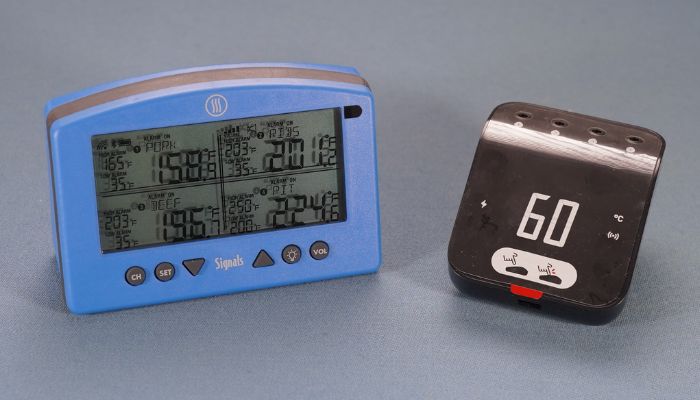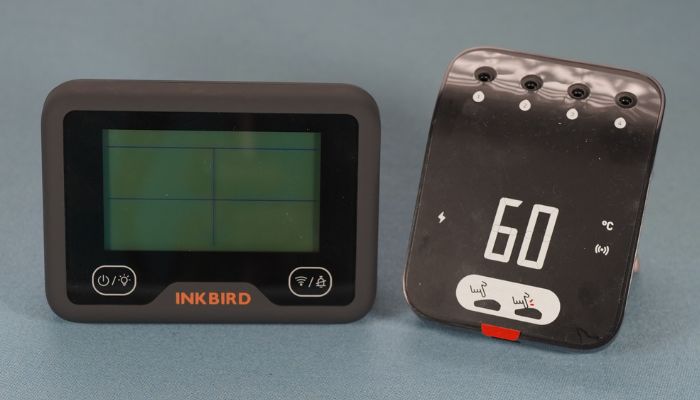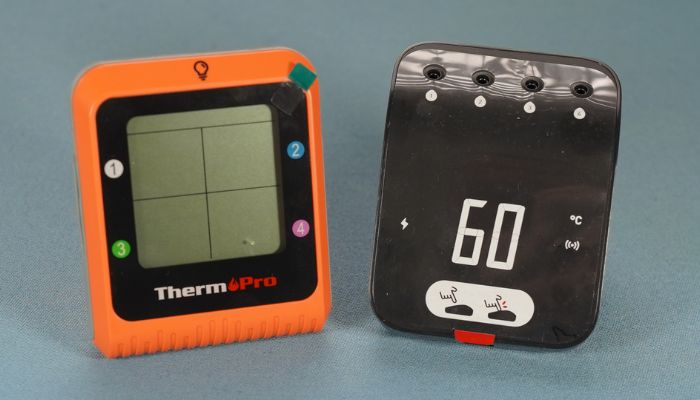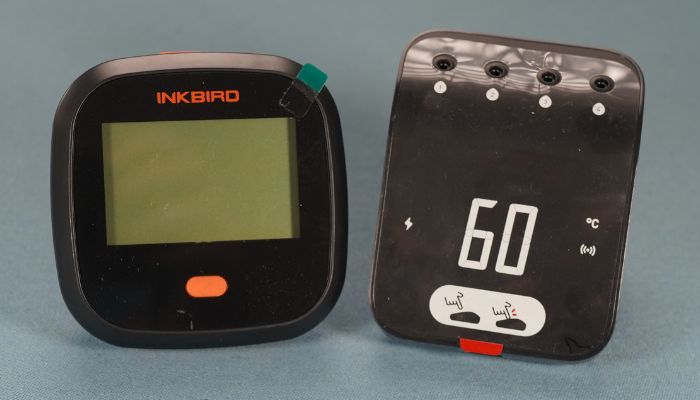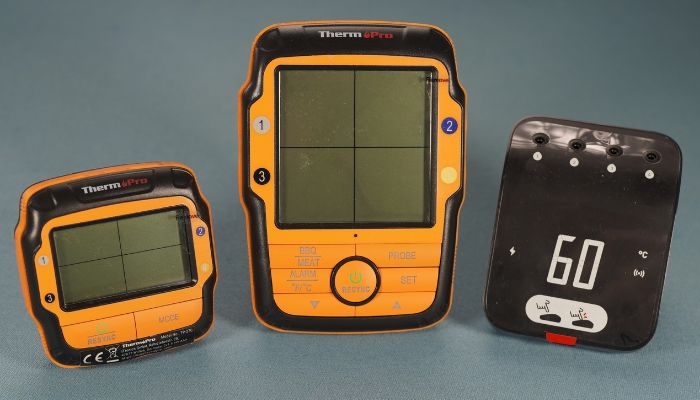Welcome to GoShindig, today I’ll be reviewing the Weber Connect smart grilling hub thermometer.
Weber has to be the biggest name in the outdoor grilling and BBQ game, they have high-end gas grills, quality Kamado style grills, advanced pellet smokers, budget-friendly kettle grills, and even electric grills. And if you think their range of grills is extensive then their range of accessories is on a completely different level.
However, the thermometer marketplace is one of the areas Weber has struggled with. So I’m going to put their Weber Connect Smart Grilling Hub through its paces and see if it’s a piece of kit that deserves the Weber name.
Contents
What’s In The Box
On opening the box, which opens like you’re offering a ring to a loved one, you are presented with a nice-looking transmitter unit. This unit comes with four-probe ports and a port for a USB to Micro USB charger. You only get two color-coded probes, one food probe, and one ambient probe. These probes come with a nice spool that makes it easy to pack the thermometer away after use. And the ambient probe comes with a grill grate clip. You also get a USB to Micro USB charger cable.
Lastly, you have the instructions manual. It’s very intuitive what to do with this thermometer, so there are just a few basic images that lead you through the setup process.
Setup
The first step in the instruction manual is to charge the device. So that’s what I did. However, when I plugged it in I did see the battery indicator flashing orange to say it already had half a charge. So if you are in a hurry you could skip this step.
Under the main unit of the Weber Connect, you will find a small bit of paper with a QR Code, which when scanned takes you to a Weber customer care webpage with lots of information and help on the thermometer. The top subject on this webpage is the “Set Up Instructions” so click on this. This leads to a new page with links to the iSO and Android app stores to download the thermometer app. Of course, you could just search for Weber Connect in the app store yourself.
Now install the app, which will take a few moments, and then open the app. Once open the only option available to you is to pair the device. Make sure the main unit is turned on, and then press this button.
You are then asked for consent for Weber to collect analytics data, I said no thanks, but you can change this later in the app if you want. The next option is to give the app access to your location or not. I gave access to location when using the app. Your phone then looks for a Weber device to pair to via Bluetooth. Once it finds your thermometer you’ll get a button to press to confirm this is the device you want to pair with. Press that button and then finish the final security check by pressing the device and you’ll be connected to Bluetooth. That final step is just to make sure your neighbor doesn’t connect to your Weber and mess with cooks.
Once paired, press the continue button and you are ready to start setting up WiFi. Of course, you don’t have to, you can skip this step and do it later or not at all. But I’m going to connect to WiFi so I pressed the “Extend Range” button.
Don’t know why, but there is now an option to select called Set up WiFi, even though that is what the last button implied. Select this option. Now you have to enter your WiFI network’s name and password. This was a little annoying as most WiFi devices I have used finds a list of network names for you and I simply select my one.
Once I had crawled down to where my router was for the network’s name, I entered this along with the password and hit the connect button. And as easy as that I now have Bluetooth and Wifi.
Key Features
A BBQ thermometer basically has one job, to read temperatures. Dual probe thermometers are designed to read both the internal temperature of the meat and the ambient temp of the grill. So to set themselves apart from the crowd the best thermometers offer many nice extras. Let’s run through these extras in the Weber Connect.
WiFi & Bluetooth
Old grilling thermometers would have probes connected to a display that you could read the temperature. Advances in technology have led to this display becoming a transmitter to transmit the readings to a receiver, meaning a pitmaster no longer needs to sit next to their grill to monitor their cooks.
These modern thermometers first shipped with their own receiver, but now, the most advanced thermometers let you use your phone as a receiver. And this is normally achieved by either WiFi or Bluetooth. The Weber Connect offers you both these options. WiFi is the most advanced of these two options, giving you the ability to monitor your cooks anywhere in the world with internet access. But if you don’t have access then you always have Bluetooth as a backup, as this only need you to turn on Bluetooth on your phone.
Main Display
The main display has to go down as a key feature, but for its minimalism and not for being data-rich like most other thermometer displays. I’ve seen several people say this is a negative feature, but I guess it all depends if you like minimalist design or not, after all, everything you need is available in the app.
The temp on the display is displayed in a big font size for easy reading and if you rotate the unit the display turns so the numbers are always shown the right way.
High/Low Alarms
You can set either a high alarm or a temp range alarm, which is basically a high/low alarm. The alarm, when triggered, is a low double beeping sound on your thermometer that isn’t unpleasant and is easy to switch off. My bigger worry would be missing the alarm.
As well as temp alarms you also have an alarm trigger if a probe accidentally gets disconnected, (check if I turn off the router the alarm sounds)
App
With the main display being so minimalist you’ll need an app that has a great interface and shows you all the info you want on a single screen. And I guess you have that on the barbecue screen of the app. You have all four probe temps here and any temp alarms or timers. You also have icons showing whether you are connected to Bluetooth or WiFi. And the last bit of useful information on this main screen is how much charge is left in the transmitter, you really don’t want this to die on you mid-cook.
So Weber has done great with this main screen. But past that, everything else is either too basic or too complicated. A basic example, in the settings cog, the only thing useful in there is changing from Fahrenheit to Celcius. You don’t have any options on how you want your alarms to work. You also can’t give your probes names, like beef or pork so you know the piece of meat it is reading. And there is no temp graph for the cook. None of these are big issues, but they are easy wins for Weber, so should be added.
A complicated example, the recipe presets are harder to understand than they should be. I like that Weber has tried to give you something unique, but they should have started with some basic presets. Like having beef, then the option or rare, medium, etc. Depending on what you choose a recommended temp should then be given. Having presets for loads of different cuts and times for cooking I feel is overkill for the average user.
All in all, a good app, but it defiantly has room for improvement.
Holders
The Webber Connect comes with a magnetic back to help place the thermometer next to your grill safely. Obviously any little extra like this helps. The magnet isn’t super strong, it feels a little weaker than other thermometers I’ve used, but it does the job it was made to do and I’ve never had it fall off once placed.
Extras
When I bought my Weber Connect, one of the extras I wasn’t happy I had to buy was two extra probes to be able to make full use of Weber’s four-probe capabilities. As this thermometer is already at the higher end of thermometers in terms of cost I think it’s a cheeky ask. I’ll probably use this thermometer between two different grills so went for an extra ambient probe and a meat probe. If you just have one grill you are better off with two extra meat probes.
If you are mad about grilling like me, you probably have lots of grill gear, and storing your items, as well as finding them after has become a problem. So I always like it when I can buy a storage case for any of the gear I purchase. And Weber has a nice case available for the Weber Connect that can fit four probes.
Most good thermometers come with magnetic holders, with the makers just assuming everyone has something metal next to their grill to stick it to. Well, Weber doesn’t assume this and offers you the option to buy a mounting kit that offers you several different ways to hold your thermometer.
How Accurate Is The Weber Connect
Unlike lots of other thermometers, especially those at the high end of the thermometer market, the Weber Connect doesn’t give a temp reading error range. So you can’t be sure the thermometer has gone through testing and the company is happy to claim your probe will not be out by a certain amount of degrees. For example, the Thermoworks Signals thermometer claims it will be correct to plus or minus 1.8 degrees Fahrenheit. I can’t find this info on the Weber Connect.
Of course, I’ll not be able to do the tests a thermometer company puts its probes through but I will be able to do the classic ice water and boiling water tests. We know ice water should read at a temp of 32F and boiling water at approximately 212F once altitude is taken into account. I have linked to a boiling water to altitude chart in the description if you want to do your own tests.
The Weber Connects reading were pretty good, and in a range where you’ll not have any problems with your cooks. The Ice water reading came in at 33F and the boiling water reading was 210F. My altitude is approximately 144 feet, so the perfect reading would be around 211.7F
Water doesn’t always boil at 212F, check this chart
Ease of Use
Once you have the thermometer set up with Bluetooth and Wifi, both of which were very easy to do, the basic functions of the thermometer are super simple. You just place a probe in the meat and the ambient probe on the grill. Turn on the transmitter and open the app and that’s it, you can now monitor temps.
I’d say the app takes a little getting used to and I think Weber should get some people to work on the user experience of the app. Some basic elements like being able to use your finger to spin the temp ranges to where you want them. Instead, you have to tap a button and then select change temp setting and then manually add the temps by pressing numbers and then selecting ok. It’s more longwinded than it should be.
Pros & Cons
I know I have mentioned it several times already, but giving you just two of the four probes the Weber Connect can handle is defiantly a con.
One feature I have to add to the cons section, even though it wasn’t as big a drawback as I imagined it would be, is the digital display only showing one probe’s temp. Compared to some of the competition this can best be described as minimalist. I said I didn’t find it that big a drawback so best I say why. With earlier additions of thermometers I used, the apps weren’t very good, or they didn’t have apps at all. So having the information available on the digital display was imperative. This isn’t the case now and I find myself going to the app more often than not as all the latest apps are of good quality.
I wanted to get some more information on the Weber Connect as the specifications on their website didn’t give much information. Most thermometers state their accuracy range, but I couldn’t find this on Weber’s site or in the instructions manual. So I looked to contact them, but this is blocked by a wall of FAQs and an automated chatbot. After a few minutes, I just gave up. So the customer service is getting marked as a con.
I’d have much rather had a USB-C charger instead of the Micro USB charging cable that comes with the Weber. This is because I have lots of small devices and nearly all use the USB-C cable, so I can easily use one of these if I can’t find my Weber cable. If you have lots of Micro USB devices this obviously won’t be an issue.
I’m not a big fan of how you turn the device on and off, there is no button as such, and you just press your finger in an area, not knowing if you are in the right spot and how much pressure to apply.
On sites like Amazon, the Weber Connect has been given many bad ratings, which has affected their overall rating, for the recipe section of their app. I think this is pretty unfair, as most thermometers don’t even have a recipe section. So a bit harsh if these reviews would have been better if Weber just deleted this section.
I’m not going to go over the pros again as I covered them in the key features section. But to recap the pros are having WiFi and Bluetooth, the ease with which this thermometer is setup, the quality app, the magnetic holder, and the nice extras I could buy. And one last pro that I’ve not mentioned is the thermometer is weather-resistant, which means you don’t have to panic with a little rain, but you can’t dunk it in a bucket of water.
Competition
As I have outlined, the Weber Connect is a great thermometer, but it isn’t perfect and other thermometers might be a better option for you. So let’s look at a few thermometers that offer many of the same features and ones that offer different key features to the Weber Connect.
We will be reviewing all the competitors in separate videos, along with many other bits of BBQ kit, so if you’d like to see this subscribe to this channel. I’d also appreciate it if you hit the like button for this video, it really helps. Thanks.
Thermoworks Signals Vs Weber Connect
If price dictates quality then the Thermoworks Signals is the best dual probe thermometer in the grilling marketplace. So it’s a great thermometer to compare the Weber Connect against.
For a start, the obvious difference. The transmitter units aren’t really comparable, Thermoworks has gone for an all singing and all dancing display. Giving you all the information you’d need from all four probes at a glance. Weber, on the other hand, has gone for a minimalist look. So do you prefer a sleek-looking cool design over the information-rich unit?
Once you look past the obvious these two thermometers are very similar. Both have Wifi and Bluetooth options and very good apps to monitor your cooks. Both have the ability to have four probes, but of course, Weber only gives you two probes. And I can’t compare the accuracy of the probes as Weber doesn’t give this information.
Check our full Thermoworks Signals review.
Inkbird IBBQ-4BW Vs Weber Connect
The Inkbird IBBQ-4BW is another dual probe thermometer that has both WiFI and Bluetooth and is defiantly a thermometer that you should consider, as the price is slightly lower than the Weber Connect and it comes with all four probes.
It will probably come as no surprise but the digital display of the transmitter on the Inkbird also displays much more info than the Weber Connect (But less than the Thermoworks Signals).
Read our Inkbird IBBQ-4BW thermometer review
ThermoPro TP930 Vs Weber Connect
WiFi is the tech that makes high-end thermometers cost so much, so if this is something your not going to use, as you always stay close to your cooks then you might be best looking at alternatives to the Weber Connect. And the ThermoPro TP930 is one such thermometer.
Like the Weber, the ThermoPro TP930 is a compact Bluetooth dual probe thermometer that can monitor four probes. They both also have quality, easy-to-install apps. And as with every other thermometer I’ve used, the transmitter of the TP930 shows more info than the Weber Connect. But not much more.
So, the question you must ask is, is having WiFI worth paying more than double what you would for the ThermPro TP930? I love having WiFI, but if I am honest with myself I rarely need this feature. But when you do need it it’s a live saver.
For more info on the ThermoPro TP930 read our review
Inkbird IBBQ-4T Vs Weber Connect
If having WiFi is a must, but you still want to save a little money, then maybe go for a thermometer with just WiFi and not WiFI & Bluetooth. The Inkbird IBBQ-4T offers this and is a great thermometer similar to the Inkbird IBBQ-4BW we mentioned earlier.
Bluetooth is very popular with thermometers, but do you need it if you have WiFi? Most people will never cook where they don’t have access to the internet, so having Bluetooth as a backup will never get used. Of course, if you work in mobile catering you might be better off having Bluetooth as an option.
Most other features on the Inkbird are very similar to the Weber, so it’s a personal choice on needing Bluetooth and saving a few bucks.
ThermoPro TP27 Vs Weber Connect
If both WiFi and Bluetooth all sounds a little too tech-savvy for you, or for the person you are buying the thermometer for, then you should have a look at the ThermoPro TP27. It is wireless still but uses old-school radio frequency instead of WiFi or Bluetooth. ThermoPro gives you a dedicated receiver to use instead of your phone.
Unlike the Weber which has most of the information on the receiver, your phone, and hardly anything on the transmitter, the TP27 has all its information on the transmitter. This part of the unit can be used as a standalone thermometer, but a nice extra is the small receive you can clip to you belt inorder to keep an eye on your cooks.
If your interested in the ThermoPro TP27 read our review.
Final Thoughts
When it comes to buying a WiFI and Bluetooth dual probe thermometer you don’t have a massive number of options. These are high-end, expensive thermometers, so are only made by a handful of the top companies. So should the Weber Connect be one of the thermometers you consider? Yes, for sure, it’s a great thermometer with some nice extras you can buy. But it is probably more expensive than it should be, considering it only comes with two probes.
Of course, if the price is not a problem for you this should be one of the thermometers at the top of your list of potentials, along with the Thermoworks Signals. And for a slightly cheaper WiFi and Bluetooth option you should look at the Inkbird IBBQ-4BW. If price is a big driving factor in your decision then I’d say have a look at the thermometers that don’t have both WiFi and Bluetooth, such as the ThermoPro TP27, TP930, and the Inkbird IBBQ-4T. These are all great thermometers so choose whichever one best suits your personal criteria.
